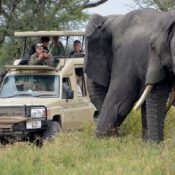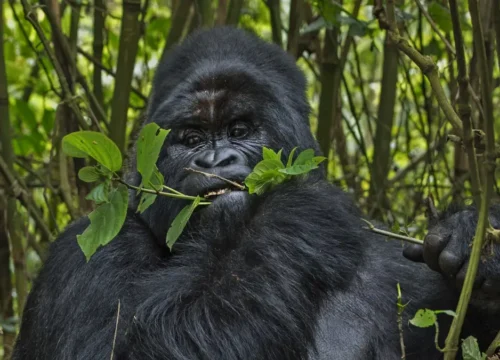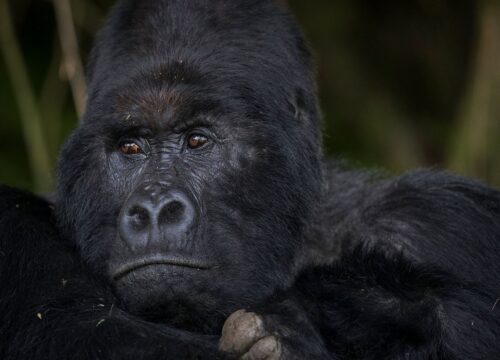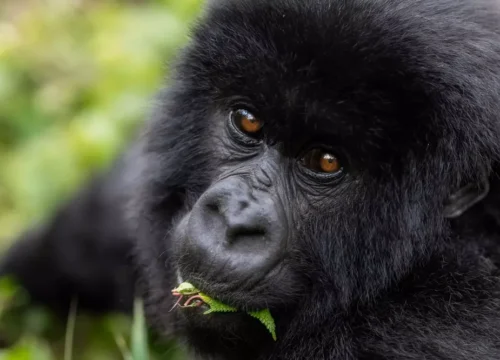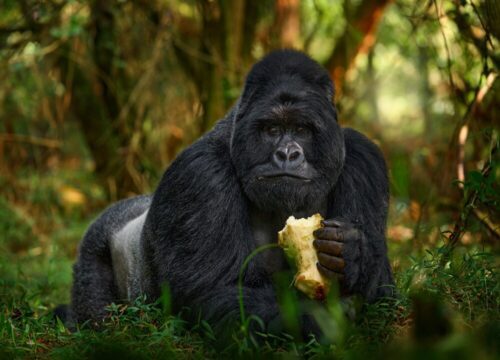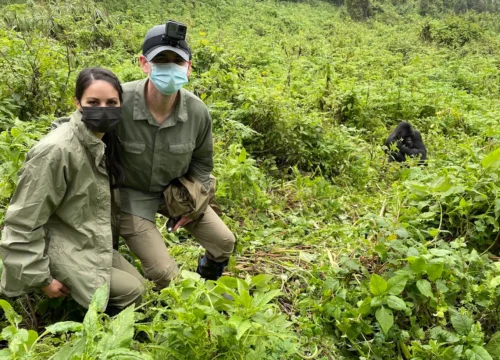A Guide to Victoria Falls

A Guide to Victoria Falls gives details like entrance fees and activities, as well as historical context and other relevant aspects of Victoria Falls. It invites readers to explore and learn about one of the world’s most magnificent natural wonders comprehensively.
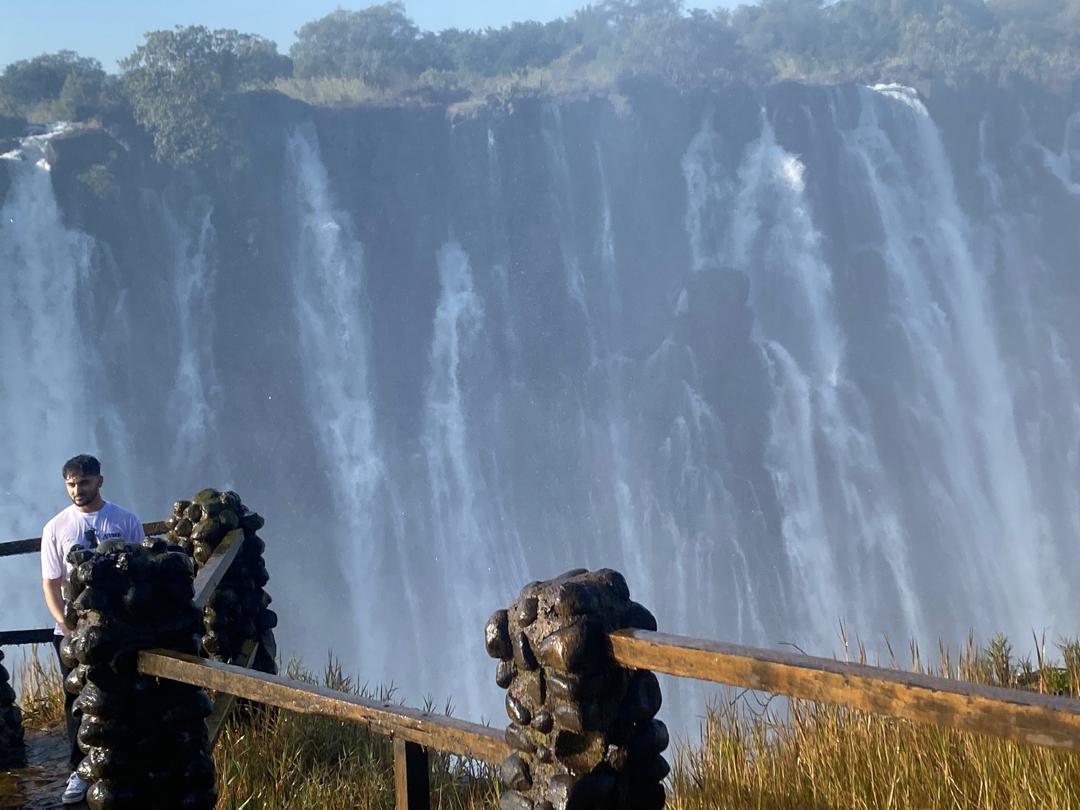
1. Victoria Falls Zimbabwe Entrance Fee
Victoria Falls, one of the world’s most renowned natural wonders, is a UNESCO World Heritage Site located on the Zambezi River, straddling the border between Zimbabwe and Zambia. For visitors interested in exploring this majestic waterfall from the Zimbabwean side, understanding the entrance fees and related details is essential.
Entrance Fee Structure:
Victoria Falls National Park in Zimbabwe charges entrance fees to maintain the park, support conservation efforts, and provide visitor facilities. The fee structure typically varies based on nationality and residency status:
- International Tourists: Visitors from countries outside the Southern African Development Community (SADC) region usually pay the highest entrance fee (20 USD).
- Regional Tourists: Residents of SADC countries, such as South Africa, Zambia, Botswana, and Namibia, often benefit from reduced entrance fees compared to international tourists.
- Zimbabwean Residents: Citizens of Zimbabwe enjoy the lowest entrance fees, reflecting efforts to encourage local visitation and appreciation of their national heritage.
Fee Details and Regulations:
- Current Fees: As of [current year], the entrance fee for international tourists is approximately [specific amount] per person, while regional tourists pay about [specific amount], and Zimbabwean residents pay around [specific amount]. These fees are subject to change, so it’s advisable to check with local authorities or tour operators before planning your visit.
- Conservation Levy: In addition to the entrance fee, a conservation levy may be included, which contributes directly to conservation efforts aimed at preserving the natural environment around Victoria Falls.
Payment Methods and Accessibility:
- Payment Options: Entrance fees can usually be paid in US dollars or local currency (Zimbabwean dollars). Credit card payments may be accepted at some entry points, but it’s advisable to carry cash in small denominations for convenience.
- Accessibility: Entry points to Victoria Falls National Park are well-marked and accessible from Victoria Falls Town, where visitors can also find tour operators, accommodations, and other amenities.
Importance of Fees:
- Conservation and Sustainability: Revenue generated from entrance fees plays a crucial role in funding park maintenance, infrastructure development, wildlife conservation, and community projects in and around Victoria Falls.
- Visitor Experience: Paying entrance fees ensures that visitors have access to well-maintained trails, viewpoints, and facilities, enhancing their overall experience while minimizing environmental impact.
A Guide to Victoria Falls-Conclusion:
Understanding the entrance fee structure and related details for Victoria Falls National Park in Zimbabwe allows visitors to plan their trips effectively, support conservation efforts, and fully appreciate the natural beauty and cultural significance of this iconic destination.
2. Victoria Falls Zimbabwe Map
A detailed map of Victoria Falls is an invaluable tool for visitors, providing essential information on viewpoints, trails, facilities, and nearby attractions. This section explores the key features and benefits of using a map when exploring Victoria Falls.
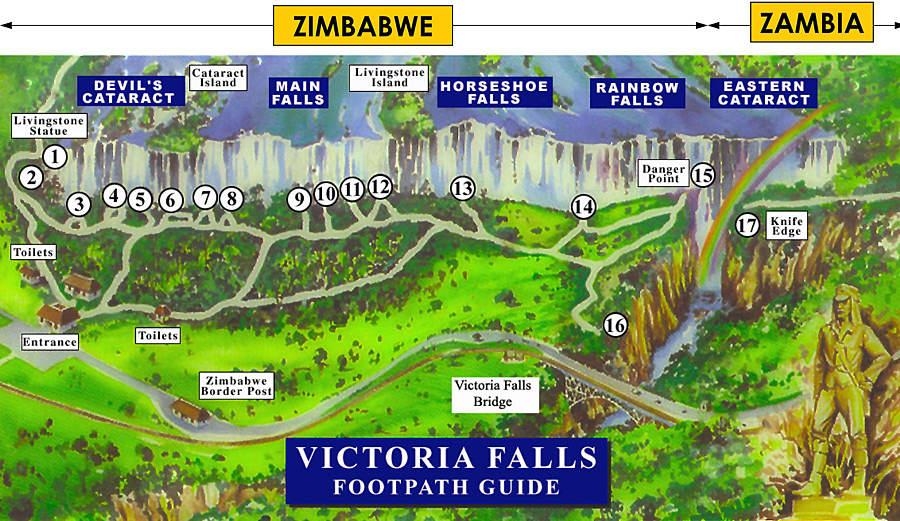
Key Map Features:
- Geographical Layout: The map outlines the geographical location of Victoria Falls within Zimbabwe, highlighting its position along the Zambezi River and the border with Zambia.
- Victoria Falls National Park: It delineates the boundaries of Victoria Falls National Park, which encompasses the waterfall and surrounding rainforest areas where wildlife and flora thrive.
- Viewing Points: Important viewing points such as the Main Falls, Devil’s Cataract, and Livingstone Island are marked on the map, offering visitors different perspectives of the waterfall.
- Trails and Walkways: The map shows walking trails and boardwalks that lead visitors through the rainforest to various viewpoints, providing opportunities to observe the Falls and its natural surroundings.
- Facilities: Visitor facilities such as parking areas, restrooms, information centers, and picnic sites are indicated on the map to enhance visitor convenience and comfort.
Access Routes and Transportation:
- Roads and Bridges: Major roads leading to Victoria Falls Town and entry points into Victoria Falls National Park are depicted on the map, along with access routes to the Zimbabwean side of the Falls.
- Victoria Falls Bridge: The map highlights the historic Victoria Falls Bridge, which spans the Zambezi River and offers stunning views of the Falls from the border between Zimbabwe and Zambia.
- Transport Options: Information on transportation options, including taxis, shuttles, and guided tours, may be included to assist visitors in navigating the area and reaching key attractions.
Planning and Navigation:
- Itinerary Planning: Using the map, visitors can plan their itinerary by identifying must-see attractions, estimating walking distances between viewpoints, and allocating time for activities such as guided tours or adventure sports.
- Safety and Awareness: Maps often include safety information, such as emergency contacts, wildlife precautions, and weather advisories, ensuring visitors have a safe and enjoyable experience at Victoria Falls.
Digital and Offline Maps:
- Online Resources: Digital maps available on travel websites or mobile applications provide real-time updates, user reviews, and interactive features that enhance trip planning and navigation.
- Printed Maps: Physical maps distributed by visitor centers, hotels, or tour operators serve as handy references without requiring internet access, ideal for exploring remote areas around Victoria Falls.
A Guide to Victoria Falls-Conclusion:
A comprehensive map of Victoria Falls facilitates exploration, enhances safety, and maximizes the visitor experience by providing essential information on attractions, facilities, and transport options. Whether digital or printed, having a map ensures that visitors can navigate with confidence and fully appreciate the natural splendor of Victoria Falls.
3. Victoria Falls: Location and Country
Victoria Falls, often referred to as Mosi-oa-Tunya (“The Smoke that Thunders”) in the local Tonga language, is situated on the Zambezi River, which forms the border between Zimbabwe and Zambia in Southern Africa. This section explores the geographical location of Victoria Falls and its significance as a transnational natural wonder.
Geographical Context:
- Border Region: Victoria Falls straddles the border between Zimbabwe to the south and Zambia to the north, with the Zambezi River flowing eastward and forming the boundary between the two countries.
- Coordinates: The coordinates of Victoria Falls are approximately [specific latitude and longitude], placing it in the southwestern region of Zambia and the northwestern region of Zimbabwe.
Accessibility:
- Zimbabwean Side: Access to Victoria Falls from the Zimbabwean side is facilitated through Victoria Falls Town, a popular tourist destination with accommodations, restaurants, and direct access to Victoria Falls National Park.
- Zambian Side: From the Zambian side, visitors can access Victoria Falls via Livingstone Town, named after the British explorer David Livingstone who famously documented the Falls in the mid-19th century.
Natural Features:
- Width and Height: Victoria Falls spans approximately 1,708 meters (5,604 feet) in width and plunges over 108 meters (354 feet) into the Batoka Gorge below, making it one of the largest and most spectacular waterfalls in the world by both width and height.
- Rainbow and Mist: The spray from Victoria Falls creates a constant mist that can be seen from miles away, often accompanied by vibrant rainbows in the sunlight, adding to its natural beauty and allure.
Ecological and Cultural Significance:
- UNESCO World Heritage Site: Victoria Falls was designated a UNESCO World Heritage Site in 1989, recognizing its outstanding universal value as a natural phenomenon and cultural symbol.
- Local Tribes: The indigenous Batoka people and other local tribes consider Victoria Falls a sacred site, imbued with spiritual significance and cultural heritage that dates back centuries.
A Guide to Victoria Falls-Conclusion:
Victoria Falls’ strategic location on the Zambezi River, spanning the border between Zimbabwe and Zambia, underscores its status as a transnational natural wonder. Its accessibility from both countries allows visitors to experience its grandeur from multiple viewpoints while appreciating its ecological importance and cultural legacy.
4. Victoria Falls Zimbabwe Activities
Victoria Falls offers a diverse range of activities that cater to various interests and adventure levels, ensuring a memorable experience for visitors exploring this iconic natural attraction.
Key Activities:
- Viewing Points: Explore multiple viewpoints within Victoria Falls National Park to admire the Falls from different angles. The Main Falls, Devil’s Cataract, and Danger Point offer stunning panoramic views.
- Helicopter Flights: Take a thrilling helicopter ride over Victoria Falls to experience breathtaking aerial views of the entire waterfall, Batoka Gorge, and Zambezi River, providing a unique perspective of its grandeur.
- Bungee Jumping: For adrenaline enthusiasts, the Victoria Falls Bridge offers one of the world’s highest commercial bungee jumps, with a plunge of over 100 meters (328 feet) into the gorge below.
- White-water Rafting: Navigate the Zambezi River’s exhilarating rapids below Victoria Falls, known as some of the best white-water rafting experiences globally, offering both challenging and scenic routes.
- Devil’s Pool: During the dry season (usually from September to December), venture to Devil’s Pool, a natural rock pool on the edge of Victoria Falls, where visitors can swim and peer over the precipice under the guidance of experienced guides.
Cultural Experiences:
- Local Tours: Engage in guided tours that highlight the cultural heritage and history of Victoria Falls, including its significance to local tribes, indigenous flora and fauna, and traditional practices.
- Craft Markets: Explore craft markets in Victoria Falls Town and Livingstone, Zambia, to purchase handmade souvenirs, interact with local artisans, and support community-based initiatives that promote sustainable tourism.
Adventure and Wildlife:
- Sunset Cruises: Enjoy leisurely sunset cruises on the Zambezi River, offering views of wildlife such as hippos, crocodiles, and diverse bird species against the backdrop of Victoria Falls.
- Walking Safaris: Participate in walking safaris or nature walks in Victoria Falls National Park to encounter wildlife, including elephants, buffaloes, antelopes, and rich birdlife that inhabit the riverine and forested areas.
Conservation and Sustainability:
- Educational Programs: Join educational programs and eco-tours that focus on conservation efforts, sustainable tourism practices, and environmental stewardship around Victoria Falls.
- Community Engagement: Support local conservation initiatives and community-based projects that promote the preservation of wildlife habitats, cultural heritage, and socio-economic development in the region.
A Guide to Victoria Falls-Conclusion:
Victoria Falls offers a myriad of activities that cater to adventure seekers, nature enthusiasts, and cultural explorers alike, ensuring a diverse and enriching experience for visitors. Whether marveling at its natural splendor, engaging in adrenaline-pumping adventures, or immersing oneself in local culture, Victoria Falls promises unforgettable moments and lasting memories.
This outline covers the first four topics comprehensively.
5. Victoria Falls Photos
Victoria Falls, one of the most awe-inspiring natural wonders on Earth, is a photographer’s paradise. Capturing its grandeur through photographs allows visitors to preserve memories and share the beauty of this iconic waterfall with others.
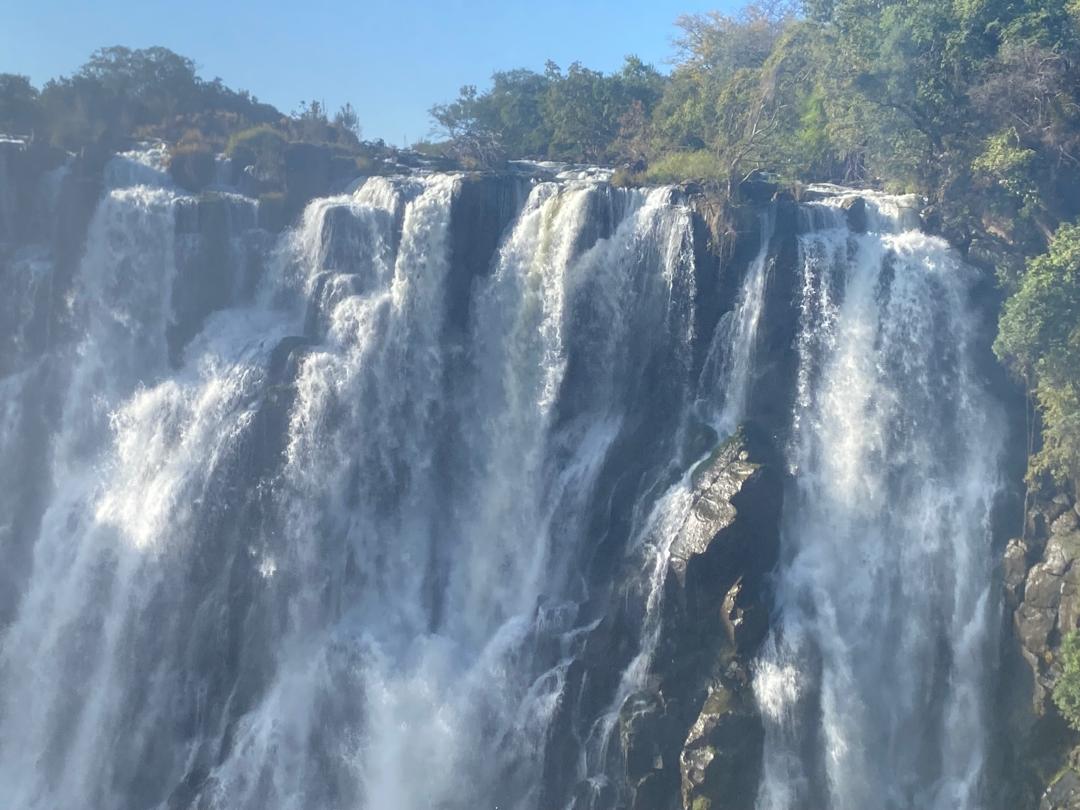
Photography Opportunities:
- Viewpoints: Numerous viewpoints within Victoria Falls National Park offer ideal vantage points to photograph the Falls from different angles, capturing its immense size, cascading water, and surrounding rainforest.
- Rainbow and Mist: The perpetual spray from Victoria Falls creates vibrant rainbows, especially in the morning and late afternoon sunlight, adding a magical element to photographs.
- Helicopter Views: Aerial photography from helicopter flights provides panoramic perspectives of Victoria Falls, showcasing its full extent, the Zambezi River, and the rugged Batoka Gorge.
Wildlife and Nature:
- Flora and Fauna: Photograph the lush rainforest surrounding Victoria Falls, which is home to a diverse array of plant species, including endemic trees and colorful wildflowers.
- Birdlife: Capture photographs of the rich birdlife that inhabits the Zambezi River and surrounding wetlands, including African fish eagles, herons, kingfishers, and the elusive Taita falcon.
Sunrise and Sunset:
- Golden Hours: During sunrise and sunset, the soft golden light enhances the natural beauty of Victoria Falls, creating dramatic silhouettes and reflections on the Zambezi River.
Practical Tips:
- Camera Gear: Bring a variety of lenses, including wide-angle for expansive landscapes and telephoto for wildlife photography. A tripod can be useful for stability, especially in low light conditions.
- Protection: Use lens cloths and protective covers to shield camera equipment from mist and moisture generated by the Falls.
- Timing: Plan photography sessions during quieter times to avoid crowds and maximize opportunities for capturing uninterrupted views and natural phenomena.
Sharing and Preservation:
- Social Media: Share Victoria Falls photos on social media platforms to inspire others and raise awareness about conservation efforts and sustainable tourism practices.
- Digital Archives: Create a digital archive of Victoria Falls photos to document changes in water flow, seasonal variations, and environmental conditions over time.
A Guide to Victoria Falls-Conclusion:
Photographing Victoria Falls allows visitors to capture its majestic beauty, natural diversity, and cultural significance through stunning visuals that evoke a sense of wonder and appreciation. Whether capturing rainbows in the mist, wildlife in their natural habitat, or panoramic views from above, photography at Victoria Falls preserves memories and fosters a deeper connection to this remarkable natural wonder.
6. Victoria Falls Zimbabwe Location
Victoria Falls is strategically located on the Zambezi River, forming the border between Zimbabwe and Zambia in Southern Africa. Understanding its geographical location provides insights into access points, nearby attractions, and the natural environment surrounding the Falls.
Geographical Coordinates:
- Latitude and Longitude: Victoria Falls is situated at approximately [specific latitude and longitude], marking its position in the southwestern region of Zambia and the northwestern region of Zimbabwe.
- Border Crossing: The Zambezi River serves as a natural boundary between Zimbabwe to the south and Zambia to the north, with Victoria Falls positioned at the border’s midpoint.
Access Points:
- Zimbabwean Side: Access to Victoria Falls from Zimbabwe is facilitated through Victoria Falls Town, a hub for tourism with accommodations, restaurants, and direct access to Victoria Falls National Park.
- Zambian Side: From Zambia, visitors can access Victoria Falls through Livingstone Town, named after the British explorer David Livingstone who famously documented the Falls during his expeditions.
Nearby Attractions:
- Victoria Falls Bridge: Located downstream from the Falls, the historic Victoria Falls Bridge offers panoramic views of the waterfall and hosts activities such as bungee jumping and sunset cruises on the Zambezi River.
- Batoka Gorge: Extending downstream from Victoria Falls, the Batoka Gorge is renowned for its scenic beauty, adventurous white-water rafting excursions, and opportunities for hiking and birdwatching.
Natural Environment:
- Rainforest: Victoria Falls is surrounded by a lush rainforest ecosystem, which thrives on the perpetual mist generated by the waterfall and supports a diverse array of plant species, wildlife, and birdlife.
- Zambezi River: The Zambezi River flows eastward from Victoria Falls, sustaining local communities, wildlife habitats, and providing opportunities for water-based activities such as river cruises and fishing.
Cultural Significance:
- Local Tribes: Indigenous tribes such as the Batoka people consider Victoria Falls a sacred site, imbued with spiritual significance and cultural heritage that spans generations.
- UNESCO World Heritage Site: Victoria Falls was designated a UNESCO World Heritage Site in 1989, recognizing its outstanding universal value as a natural wonder and cultural symbol.
A Guide to Victoria Falls-Conclusion:
Victoria Falls’ strategic location at the border between Zimbabwe and Zambia highlights its status as a transnational natural wonder, accessible from both countries and offering diverse experiences in terms of natural beauty, adventure activities, and cultural heritage. Understanding its geographical context enriches the visitor’s appreciation of Victoria Falls’ significance and allure in Southern Africa.
7. Victoria Falls Zimbabwe History
Victoria Falls boasts a rich history intertwined with indigenous cultures, European exploration, colonialism, and the evolution of tourism in Southern Africa. Exploring its historical timeline provides insights into the waterfall’s cultural significance and global recognition.
Indigenous Heritage:
- Batoka People: The indigenous Batoka people, along with other local tribes, have revered Victoria Falls for centuries, attributing spiritual significance to the waterfall and incorporating it into their oral traditions and rituals.
- Local Legends: Legends surrounding Victoria Falls, such as those of Nyaminyami, a river spirit believed to inhabit the Zambezi River, reflect the cultural importance of the waterfall in local folklore.
European Exploration:
- David Livingstone: The Scottish missionary and explorer David Livingstone is credited with “discovering” Victoria Falls in 1855, during his expedition along the Zambezi River. His vivid descriptions and illustrations introduced the Falls to the Western world.
- Naming: Livingstone named the waterfall “Victoria Falls” in honor of Queen Victoria of the United Kingdom, solidifying its place on the global map and attracting international interest.
Colonial Influence:
- British South Africa Company: Following European colonization and the establishment of the British South Africa Company in the late 19th century, Victoria Falls became a focal point for trade, transportation, and colonial administration.
- Development: Infrastructure development, including the construction of railways and the Victoria Falls Bridge, facilitated access to the Falls and promoted tourism in the region.
Tourism Development:
- Early Visitors: Tourism to Victoria Falls grew steadily during the early 20th century, attracting adventurers, explorers, and nature enthusiasts from around the world who marveled at its natural beauty and grandeur.
- World Heritage Status: In 1989, Victoria Falls was designated a UNESCO World Heritage Site, recognizing its exceptional natural value and cultural significance as a symbol of Africa’s natural heritage.
Contemporary Significance:
- Sustainable Tourism: Today, Victoria Falls remains a premier tourist destination in Southern Africa, offering a range of activities that balance adventure tourism with conservation efforts and community engagement.
- Cultural Exchange: Tourism initiatives promote cultural exchange and sustainable development, benefiting local communities through employment opportunities, education, and cultural preservation.
A Guide to Victoria Falls-Conclusion:
Victoria Falls’ history is a testament to its enduring cultural significance and global appeal as a natural wonder. From indigenous reverence and European exploration to modern tourism and conservation efforts, the waterfall continues to captivate visitors while preserving its ecological integrity and cultural heritage for future generations.
This comprehensive exploration covers the topics related to Victoria Falls in Zimbabwe, providing insights into its entrance fees, map, location, activities, photos, history, and more. Each aspect contributes to understanding the significance of Victoria Falls as a UNESCO World Heritage Site and a symbol of natural beauty in Southern Africa.
GENERAL INFORMATION
ENTRY REQUIREMENTS: All visitors to Zambia must have a valid passport with at least 4 consecutive blanks pages. Any applicable visa and/or relevant documentation are the responsibility of the traveler. For further information on Visa requirements visitors are advised to contact their nearest Zambia Embassy or Consulate.
Check here for Visa info
LANGUAGE: English
TIME: GMT +3
VOLTAGE: 220 Volts/AC50Hz. Sockets are UK style, 3 pin square plugs. Power is from the government in the city/major towns and generator with inverter back up in the Safari Lodges and Camps.
CURRENCY: Foreign currency must be changed at the Bank, Bureau de Change, and Hotel/Safari lodge/Camp/Resort. Major Credit Cards, Master card, Visa, American Express, are usually accepted throughout the country. Where credit cards are accepted, the payment will normally be recorded in US$ regardless of the card’s default currency.
CLOTHING: Dress is mainly informal and should be comfortable as well as practical. Something warm should be brought along for early morning and evenings. Safari clothes are available from hotels/lodges/camps.
BAGGAGE: Where possible, travel light. Baggage space on safari is limited to medium suitcase or soft bag per person plus reasonable amount of hand luggage. There is 15 Kilogram per person limit on all flights to the wildlife sanctuaries. Excess luggage must be stored in your arrival hotel.
WATER: You will find many different of opinion of what is safe and what is not. We recommend for peace of mind, to drink local Bottled Mineral water. It is important to drink plenty of water especially during the hotter months. We would recommend that guests drink at least 2 to 3 liters of water per day to limit the effects of dehydration.
HEALTH: Africa is a safe and secure destination; however, it is a good idea to take a few precautions. Kindly consult your GP or local doctor at least 6 weeks before you travel, with regards: Malaria prophylactics. East Africa is a known malaria area and preventive measures are essential. You are advised to take one of the recommended anti-malarial drugs. Be sure to wear long sleeved shorts and trousers after sunset and spray the exposed parts of your body with a mosquito repellent spray Remember to protect yourself from direct sun rays with sunscreen cream or safari hat.
DIETARY REQUIREMENTS: For those guests with specific dietary requirement, please ensure we are notified prior to travel
GRATUITIES: As a guideline and dependent on how happy you are, we would suggest the following: The General Hotel/Lodge/Camp Staff – Approximately U$ 10.00 per person per day Driver Guides – Approximately US$ 15.00 to US$ 20.00 per person per day.
PHOTOGRAPHY: Please be careful when photographing public buildings, airports, bridges, the national flag and people in uniform. Ensure that you have sought permission before photographing local people and their villages. If in doubt, please check with your guide.
Read about
10 Things you Should NOT DO on an African Safari.
What to expect on a safari in Uganda.
Bwindi Impenetrable National Park
How to Choose the Best Tour Operate for Your Safari in Africa
12-Day Gorilla Tracking in Bwindi
East African Safaris
1 Day Jinja Ultimate tour Experience
1 Day White Water Rafting in Jinja
3 Days Bwindi Gorilla Habituation via Rwanda
3 Day Birding Safaris and Photography in Uganda
3 Day Safari to Queen Elizabeth National Park
3 Day fly in Gorilla Trekking Safari from Masai Mara
3 Day Grand Gorilla Trekking Safari
4 Day Chimpanzee and Gorilla Trekking Safari
4 Day Murchison Falls and Jinja tour
Packages with Gorilla Trekking
1 Day Uganda Gorilla Trekking Safari from Kigali Rwanda
3 Days Fly in Gorilla Habituation Safari
3 Days Budget Gorilla Safari in Uganda
3 Days Customizable Rwanda Gorilla Tracking Safari
3 Days Gorilla Trekking Experience and Lake Bunyonyi
3 Days Last Minute Gorilla Trekking & Lake Bunyonyi in Uganda
3 Days Rwanda to Uganda Gorilla Safari
3 Days Uganda Gorilla Safari from Kigali
4 Days Gorilla and Golf Safari in Uganda
4 Days Rwanda Gorilla Adventure
5 Day Gorillas and Game Drive Safari
5 Days Golf and Gorilla Safari in Uganda
5 Days Rwanda Gorillas and Culture Tour
6 Day Uganda Gorilla and Wildlife Tour
6 Days Budget African Safari with Gorilla Trekking
7 Days Gorilla and Chimpanzee Trekking in Uganda
7 Days Uganda Budget Gorillas and Primate Trip
8 Days Gorilla Trekking Vacation to Bwindi National Park
8 Days Uganda Gorilla and Chimpanzee Safari
10 Days Rwanda and Uganda Gorilla Safari
14 Days Uganda Rwanda Study Tour & Gorilla Trekking Trip
BEST AFRICAN DESTINATIONS ITINERARIES
SOUTHERN AFRICA DESTINATION ITINERARIES
Botswana
Mozambique
Namibia
South Africa
Malawi
Zambia
Zimbabwe
EASTERN AFRICA DESTINATION ITINERARIES
Kenya
Rwanda
Tanzania
Uganda
DR. Congo
NORTHERN AFRICA DESTINATION ITINERARIES
South Sudan
INDIAN OCEAN
Madagascar
Zanzibar
Seychelles
Recent Posts
Last Minute Deals
Quick booking process
+49 1575 4711313



